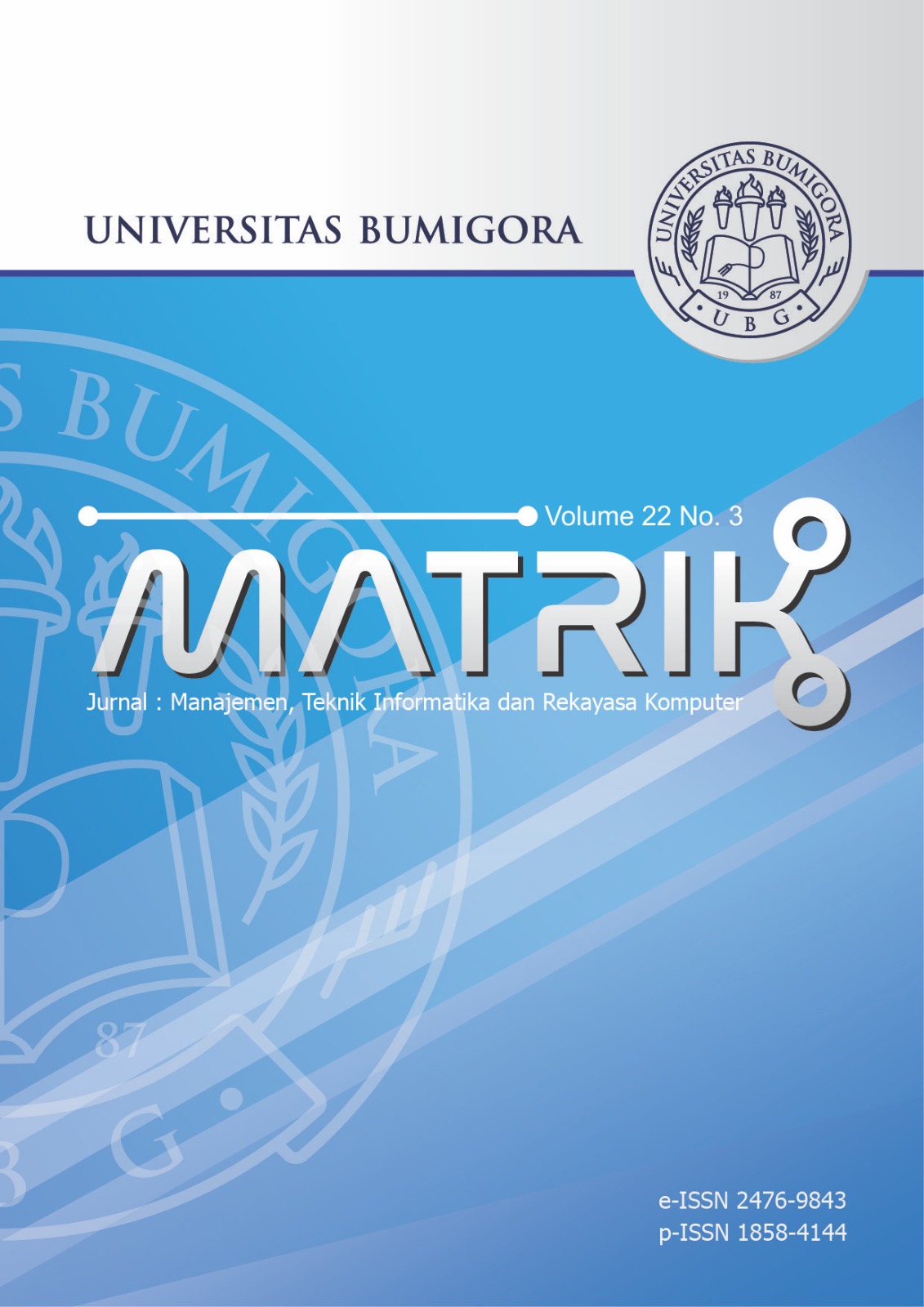Digital Forensic Analysis of WhatsApp Business Applications on Android-Based Smartphones Using NIST
DOI:
https://doi.org/10.30812/matrik.v22i3.3033Keywords:
Android, Digital Evidence, Digital Forensics, MOBILedit, National Institute of Standards and Technology, WhatsApp BusinessAbstract
WhatsApp Business is an Android application that can be downloaded on Playstore to serve small business owners. This provides an opportunity for criminals to take advantage of the app’s features. These crimes can take the form of fraud, misdirection, and misuse of applications, so digital forensics is necessary because there has never been any research that has done this. This study aims to obtain digital evidence and is carried out on Android smartphones with the WhatsApp Business application installed with four scenarios tested. This study uses the NIST SP 800-101 Rev 1 guidelines with four stages: preservation, acquisition, inspection & analysis, and reporting. The forensic method used is static forensics using the MOBILedit forensic express forensic tools and SysTools SQLite Viewer. The results of this study in scenario 1, by not deleting, get a 100% percentage. Then, scenario 2, namely direct write-off, gets a percentage of 71%. Furthermore, scenario 3, namely uninstalling the application, does not get digital evidence, and scenario 4, namely deleting data through the application manager, also does not get any evidence. The contribution of this research is expected to be a reference in uncovering cases in the WhatsApp Business application with digital forensics.
Downloads
References
[2] D. Curry, “Android Statistics (2022),†BusinessofApps, 2022. https://www.businessofapps.com/data/android-statistics/ (accessed Dec. 19, 2022).
[3] WhatsApp, “Apa Itu Aplikasi WhatsApp Business?†https://faq.whatsapp.com/641572844337957/?locale=id_ID (accessed Apr. 01, 2023).
[4] D. Astria, M. Santi, and S. Muhammadiyah Tulungagung, “Pemanfaatan Aplikasi Whatsapp Bisnis Dalam Strategi Pemasaran Online Untuk Meningkatkan Jumlah Penjualan,†Tulungagung, Dec. 2021. [Online]. Available: http://ejournal.staim-tulungagung.ac.id/index.php/Eksyar
[5] L. Ceci, “Number of WhatsApp Business downloads worldwide from 2018 to 2021 (in millions),†Statista, Jan. 2023, Accessed: Apr. 01, 2023. [Online]. Available: https://www.statista.com/statistics/1305771/whatsapp-business-downloads-worldwide/
[6] Stephanie Chevalier, “Countries with the highest number of WhatsApp Business app downloads as of June 2022(in millions),†Statista, Jan. 27, 2023. https://www.statista.com/statistics/1276030/whatsapp-business-downloads-leading-countries/ (accessed Apr. 01, 2023).
[7] Raymond SM Tampubolon and Akhmad Zaenuddin, “Status Hukum Interaksi Bisnis Melalui WhatsApp,†KABAR24, Nov. 09, 2020. https://kabar24.bisnis.com/read/20201109/16/1315273/status-hukum-interaksi-bisnis-melalui-whatsapp (accessed Apr. 01, 2023).
[8] Mohammad Faruq Afif, “Metode Clustering Storage untuk Penyimpanan Bukti Digital Menggunakan Software Defined Storage,†Universitas Islam Indonesia, Oct. 16, 2019. https://dspace.uii.ac.id/handle/123456789/18258 (accessed Apr. 01, 2023).
[9] R. Tamma, O. Skulkin, H. Mahalik, and S. Bommisetty, “Practical Mobile Forensics: Forensically investigate and analyze iOS, Android, and Windows 10 devices,†2014.
[10] ANGGIS TIYANA BR SITUNGKIR, “Tinjauan Yuridis Terhadap Digital Forensik Dalam Menganalisis Barang Bukti Digital Dalam Pembuktian Tindak Pidana Ditinjau Dari Undang-Undang No 11 Tahun 2008 Junto Undang-Undang No 19 Tahun 2016 Tentang Informasi Dan Transaksi Elektronik,†2018.
[11] H. Arshad, A. Bin Jantan, and O. I. Abiodun, “Digital forensics: Review of issues in scientific validation of digital evidence,†Journal of Information Processing Systems, vol. 14, no. 2, pp. 346–376, 2018, doi: 10.3745/JIPS.03.0095.
[12] X. Zhang, K.-K. Raymond, and C. Editors, “Forensic Education An Experiential Learning Approach,†2019. Accessed: Dec. 11, 2022. [Online]. Available: http://www.springer.com/series/11970
[13] M. N. Al-Azhar, “Digital Forensic,†Jakarta: Puslabfor Bareskim Polri, 2012.
[14] R. Stoykova, “Digital evidence: Unaddressed threats to fairness and the presumption of innocence,†Computer Law and Security Review, vol. 42, Sep. 2021, doi: 10.1016/j.clsr.2021.105575.
[15] M. S. Jafri, S. Raharjo, and M. R. Arief, “Implementation of ACPO Framework for Digital Evidence Acquisition in Smartphones,†vol. 15, no. 1, 2022.
[16] R. Ayers, S. Brothers, and W. Jansen, “Guidelines on mobile device forensics,†Gaithersburg, MD, May 2014. doi: 10.6028/NIST.SP.800-101r1.
[17] A. Yudhana, “Perbandingan Tool Forensik pada Mozilla Firefox Private Mode Menggunakan Metode NIST.†[Online]. Available: http://jurnal.itg.ac.id/
[18] I. Riadi, “PERBANDINGAN TOOL FORENSIK DATA RECOVERY BERBASIS ANDROID MENGGUNAKAN METODE NIST,†Jurnal Teknologi Informasi dan Ilmu Komputer (JTIIK), vol. 7, no. 1, pp. 197–204, 2020, doi: 10.25126/jtiik.202071921.
[19] M. Dweikat, D. Eleyan, and A. Eleyan, “Digital Forensic Tools Used in Analyzing Cybercrime,†Journal of University of Shanghai for Science and Technology, vol. 23, no. 3, Mar. 2021, doi: 10.51201/Jusst12621.
[20] A. N. Ichsan and I. Riadi, “Mobile Forensic on Android-based IMO Messenger Services using Digital Forensic Research Workshop (DFRWS) Method,†Int J Comput Appl, vol. 174, no. 18, pp. 34–40, Feb. 2021, doi: 10.5120/ijca2021921076.
[21] I. Riadi, H. Herman, and N. H. Siregar, “Mobile Forensic of Vaccine Hoaxes on Signal Messenger using DFRWS Framework,†MATRIK : Jurnal Manajemen, Teknik Informatika dan Rekayasa Komputer, vol. 21, no. 3, pp. 489–502, Jul. 2022, doi: 10.30812/matrik.v21i3.1620.
[22] K.D.O Mahendra and I.K.A Mogi, “Digital Forensic Analysis of Michat Applications on Android as Digital Proof in Handling Online Prostitution Cases,†Jurnal Elektronik Ilmu Komputer Udayana , vol. Volume 9 No. 3, 2021.
[23] Ltd. SysTools Software Pvt, “SysTools SQLite Viewer.†https://www.systoolsgroup.com/sqlite-viewer.html (accessed Dec. 17, 2022).
Downloads
Published
Issue
Section
How to Cite
Similar Articles
- Winny purbaratri, Hindriyanto Dwi Purnomo, Danny Manongga, Iwan Setyawan, Hendry Hendry, Sentiment Analysis of e-Government Service Using the Naive Bayes Algorithm , MATRIK : Jurnal Manajemen, Teknik Informatika dan Rekayasa Komputer: Vol. 23 No. 2 (2024)
- Dimas Afryzal Hanan, Ario Yudo Husodo, Regania Pasca Rassy, Sentiment Study of ChatGPT on Twitter Data with Hybrid K-Means and LSTM , MATRIK : Jurnal Manajemen, Teknik Informatika dan Rekayasa Komputer: Vol. 24 No. 2 (2025)
- Samsurizal Samsurizal, Arif Nur Afandi, Mohamad Rodhi Faiz, Artificial Intelligence Enhanced Direct Current Fast ChargingIntegration for Electric Vehicles on 20 kV Grids: A Technical andOntological Study , MATRIK : Jurnal Manajemen, Teknik Informatika dan Rekayasa Komputer: Vol. 24 No. 3 (2025)
- Gustin Setyaningsih, Muhamad Awiet Wiedanto Prasetyo, Debby Ummul Hidayah, Penerapan Aplikasi Media Pembelajaran pada SMP N 1 Nusawungu Berbasis Smartphone Android , MATRIK : Jurnal Manajemen, Teknik Informatika dan Rekayasa Komputer: Vol. 18 No. 2 (2019)
- Magdalena Ariance Ineke Pakereng, Alz Danny Wowor, Yos Richard Beeh, Felix David, Erwien Christianto, Vincent Exelcio Susanto, Claudio Canavaro, Square Transposition Method with Adaptive Key Flexibility and Strong Diffusion Performance , MATRIK : Jurnal Manajemen, Teknik Informatika dan Rekayasa Komputer: Vol. 24 No. 3 (2025)
- Imanuddin Imanuddin, Fachrid Alhadi, Raza Oktafian, Ahmad Ihsan, Deteksi Mata Mengantuk pada Pengemudi Mobil Menggunakan Metode Viola Jones , MATRIK : Jurnal Manajemen, Teknik Informatika dan Rekayasa Komputer: Vol. 18 No. 2 (2019)
- Djoko Kuswanto, Athirah Hersyadea Alifah Putri, Ellya Zulaikha, Tedy Apriawan, Yuri Pamungkas, Evi Triandini, Nadya Paramitha Jafari, Thassaporn Chusak, Cranioplasty Training Innovation Using Design Thinking: AugmentedReality and Interchangeability-Based Mannequin Prototype , MATRIK : Jurnal Manajemen, Teknik Informatika dan Rekayasa Komputer: Vol. 24 No. 3 (2025)
- Rendy Rian Chrisna Putra, Tri Sugihartono, Penerapan Algoritma Fisher-Yates Shuffle pada Computer Based Test Ujian Sekolah di SMKN 1 Payung , MATRIK : Jurnal Manajemen, Teknik Informatika dan Rekayasa Komputer: Vol. 18 No. 2 (2019)
- Abd Mizwar A Rahim, Andi Sunyoto, Muhammad Rudyanto Arief, Stroke Prediction Using Machine Learning Method with Extreme Gradient Boosting Algorithm , MATRIK : Jurnal Manajemen, Teknik Informatika dan Rekayasa Komputer: Vol. 21 No. 3 (2022)
- Helna Wardhana, I Made Yadi Dharma, Khairan Marzuki, Ibjan Syarif Hidayatullah, Implementation of Neural Machine Translation in Translating from Indonesian to Sasak Language , MATRIK : Jurnal Manajemen, Teknik Informatika dan Rekayasa Komputer: Vol. 23 No. 2 (2024)
You may also start an advanced similarity search for this article.


.png)












